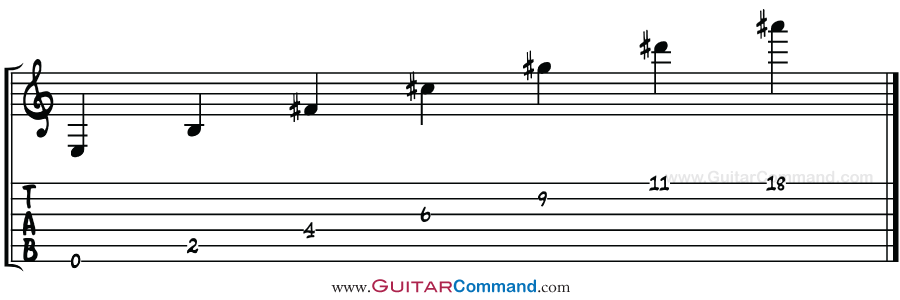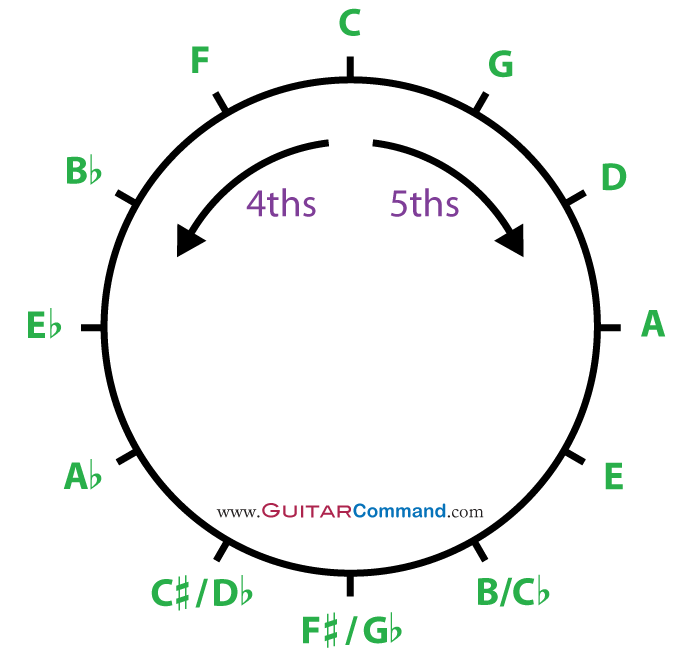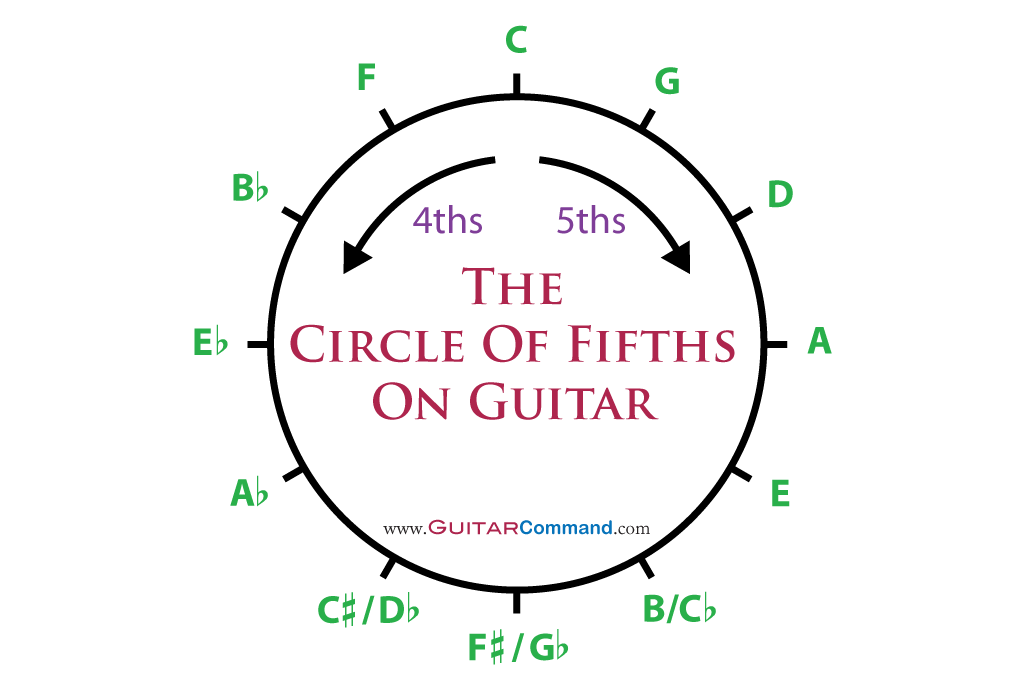A guide to the circle of fifths on guitar. A guitar-related explanation of this fundamental musical concept.
The Circle Of Fifths On Guitar
In the previous article – What Is The Circle Of Fifths? – we looked at the theory behind the circle of fifths. This page will be much more practical, with TABs you can play in order to memorize and use the cycle of fifths.
Page Index
Musical Terms Used On This Page
At the bottom of this page you'll find explanations of the musical terms used on this page. Use the quick links below to go to the desired term if you're unsure of its meaning.
The Circle Of Fifths Explained
The circle of fifths is a sequence of notes in which every note is a perfect fifth interval higher than the preceding note.
If the octave of each note is disregarded then the sequence will pass through all 12 notes of the chromatic scale before returning to the starting note.
The circle of fifths is used to describe the relationship between the notes of the chromatic scale and their corresponding chord signatures. It's also a useful way of learning key signatures and the relationships between different keys.
The circle of fifths is often represented as a circular diagram, as it can start on any of the twelve notes of the chromatic scale and will always return to the starting note.
If you practice playing a chord, chord progression, scale or arpeggio by transposing it through all 12 notes using the circle of fifths, you'll have played it with every possible root note / in every possible key. This is a great way of improving your knowledge of the fretboard.
You can also use the circle of fifths to come up with new chord progressions and for inspiration while songwriting.
How To Play The Circle Of Fifths On Guitar
If you try to play the entire circle of fifths on guitar starting on the lowest possible note (i.e. the open bottom E string) and going up a perfect fifth interval at a time then you quickly run out of frets:

... But the circle of fifths isn't a melody. It's more a way of demonstrating the relationships between notes, chords and key signatures. For this reason the actual octave of the notes in the circle of fifths sequence is disregarded.
When we work out the circle of fifths, we're concerned with the note name (e.g. 'C', 'Ab', etc.), rather than the octave of the note.
Below is the circle of 5ths starting on the bottom E, but with all of the notes brought down into the same octave:
Circle of 5ths Starting On E

By playing through the circle of fifths you will have played all of the twelve notes of the chromatic scale before returning to the start note.
This is true whatever note you start on, which is why the circle of fifths is a circle!
Basic Circle Of Fifths Diagram
Due to the cyclic nature of the circle of fifths it is usually represented as a clock-like diagram. Starting with a C at the 12-o-clock position, the notes of the sequence are positioned clockwise around the circle.

- A more complex version of the diagram can be see on this page: What Is The Circle Of Fifths?
Below are the notes in the circle of fifths starting on C:
C > G > D > A > E > B > F# / Gb > C# / Db > G# / Ab > D# / Eb > A# / Bb > F > C
Again, we're only interested in the 'name' of the note (e.g. 'C', 'Ab', etc.) rather than the octave at which it's being played.
The TAB below shows one of the many ways of playing the circle of fifths on guitar:
Circle Of Fifths Guitar TAB
Play through the circle of fifths on your guitar in order to get an idea of where the notes are on the fretboard in relation to each other.
Notice the 'pattern' the notes make on the fretboard. Being able to locate the note a perfect fifth away from another note is a useful skill to have.
For example, you may want to find the V7 chord of a chord progression, or to play the Mixolydian modal scale, both of which are found a perfect 5th away from the root note of a scale.

As we've seen, by transposing the notes so that they are all in the same octave (as they are above) the circle of fifths contains every note in a one-octave chromatic scale.
TAB for a one-octave chromatic scale is provided below for comparison. (Note that pairs of notes such as A flat and G sharp are essentially the same notes, and are both played at the same fret.)
Chromatic Scale TAB

No matter what the starting note, if you play each note a perfect fifth higher than the last, then you’ll find yourself back at the starting note after having played all 12 notes of the chromatic scale (providing you disregard the octaves at which the notes are played).
Below are more ways of playing the circle of 5ths on guitar. In these versions of the sequence you're not restricted to staying in one octave.
Notice the pattern the perfect fifth intervals make on the fretboard. Working your way through the circle of fifths will allow you to build up a good working knowledge of the fretboard.
Cycle Of Fifths Starting On C

Another way of playing the sequence is shown below:

Circle of 5ths Starting On A

The Circle Of Fourths On Guitar
Moving counter-clockwise around the circle of fifths, the notes rise in perfect 4th intervals, giving you a circle of fourths.
The cycle of 4ths starting on C is shown below:
C > F > Bb/G# > Eb/D# > Ab/G# > Db/C# > Gb /F# > B > E > A > D > G > C
Because chord progressions often move in 4ths some musicians – particularly those who specialize in jazz – prefer to learn the circle of fourths rather than the circle of fifths.
Play the circle of fourths on your guitar, again taking note of the pattern the fourth intervals make on the fretboard.

Another example, this time starting on E:

(You can play some chord progressions that move in 4ths further down the page.)
Related Pages on Guitar Command
- Learn all of the chords in each key here: Diatonic Chords
- Learn guitar scales for soloing and composition here: Guitar Scales
Terms / Concepts Used On This Page
Perfect Fifth
In music, an interval is the distance between two notes. A perfect fifth is the interval corresponding to 7 semitones / half steps (i.e. 7 frets on a guitar neck). Therefore, the interval between a C and the G above it is a perfect fifth, as is the interval between a D and the A above it.

Perfect Fourth
Like a perfect fifth, a perfect fourth is an interval between two notes. It corresponds to 5 semitones / half steps. The interval between a C and the F immediately above it is a perfect fourth, as is the interval between a G and the C immediately above it.
Chromatic Scale
The chromatic scale is a scale in which each note is a semitone (half-step) higher than the previous note and a semitone lower than the subsequent note.
Below is the chromatic scale starting on C in TAB.



